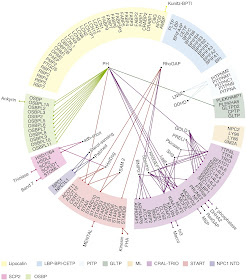There is a asymmetric phospholipid distribution in the bilayer. Three families of proteins are responsible for the translocation of phospholipids between the two monolayers (1):
- Flippases move phospholipids from the outer to the inner monolayer.
- Floppases do the opposite operation.
- Scramblases move phospholipids in both directions.
ATP10A and ATP11A
Flippase ATP10A flips phosphatidylcholine at the plasmamembrane. This activity drives membrane curvature (2).
Flippase ATP11A has flippase activity toward phosphatidylserine and phosphatidylethanolamine (3).
The gene ATP10A has changed DNA methylation pattern in peripheral blood mononuclear cells (PBMC) from ME patients (4, 5, 6).
The gene ATP11A has changed DNA methylation pattern in PBMC from ME patients (4, 5).
PLSCR1 and PLSCR3
Phospholipid scramblase 1 (PLSCR1) is also known as erythrocyte phospholipid scramblase.
Use link to see figure (7):
https://www.ncbi.nlm.nih.gov/pmc/articles/PMC5992676/figure/F7/
PLSCR1 aggravates anaphylactic reactions by increasing FcεRI-dependent mast cell degranulation. (8).
PLSCR3 may be involved in translocation of cardiolipin from the inner to the outer mitochondrial membrane (1).
Use link to see figure (7):
https://www.ncbi.nlm.nih.gov/pmc/articles/PMC5992676/figure/F7/
PLSCR1 aggravates anaphylactic reactions by increasing FcεRI-dependent mast cell degranulation. (8).
PLSCR3 may be involved in translocation of cardiolipin from the inner to the outer mitochondrial membrane (1).
PLSCR1 gene expression in whole blood was related to ME/CFS in adolescents (9, 10).
The gene PLSCR3 was hypomethylated in PBMC from ME patients (6). And PLSCR3 was differntially methylated in PBMC from ME patient subtypes (5).
CRIM1 and PLSCRs
CRIM1 interacts with PLSCRs (11):
CRIM1: Cysteine rich transmembrane BMP regulator 1 (chordin-like); May play a role in CNS development by interacting with growth factors implicated in motor neuron differentiation and survival. May play a role in capillary formation and maintenance during angiogenesis. Modulates BMP activity by affecting its processing and delivery to the cell surface (11).
PLSCR1: Phospholipid scramblase 1; May mediate accelerated ATP-independent bidirectional transbilayer migration of phospholipids upon binding calcium ions that results in a loss of phospholipid asymmetry in the plasma membrane. May play a central role in the initiation of fibrin clot formation, in the activation of mast cells and in the recognition of apoptotic and injured cells by the reticuloendothelial system (11).
Phospholipid scramblase 2; May mediate accelerated ATP-independent bidirectional transbilayer migration of phospholipids upon binding calcium ions that results in a loss of phospholipid asymmetry in the plasma membrane. May play a central role in the initiation of fibrin clot formation, in the activation of mast cells and in the recognition of apoptotic and injured cells by the reticuloendothelial system (11).
PLSCR3: Phospholipid scramblase 3; May mediate accelerated ATP-independent bidirectional transbilayer migration of phospholipids upon binding calcium ions that results in a loss of phospholipid asymmetry in the plasma membrane. May play a central role in the initiation of fibrin clot formation, in the activation of mast cells and in the recognition of apoptotic and injured cells by the reticuloendothelial system. Seems to play a role in apoptosis, through translocation of cardiolipin from the inner to the outer mitochondrial membrane (11).
The gene CRIM1 has changed DNA methylation pattern in PBMC from ME patients (4, 5, 6), and in CD4+ T-cells from ME patients (12).
CRIM1: Cysteine rich transmembrane BMP regulator 1 (chordin-like); May play a role in CNS development by interacting with growth factors implicated in motor neuron differentiation and survival. May play a role in capillary formation and maintenance during angiogenesis. Modulates BMP activity by affecting its processing and delivery to the cell surface (11).
PLSCR1: Phospholipid scramblase 1; May mediate accelerated ATP-independent bidirectional transbilayer migration of phospholipids upon binding calcium ions that results in a loss of phospholipid asymmetry in the plasma membrane. May play a central role in the initiation of fibrin clot formation, in the activation of mast cells and in the recognition of apoptotic and injured cells by the reticuloendothelial system (11).
Phospholipid scramblase 2; May mediate accelerated ATP-independent bidirectional transbilayer migration of phospholipids upon binding calcium ions that results in a loss of phospholipid asymmetry in the plasma membrane. May play a central role in the initiation of fibrin clot formation, in the activation of mast cells and in the recognition of apoptotic and injured cells by the reticuloendothelial system (11).
PLSCR3: Phospholipid scramblase 3; May mediate accelerated ATP-independent bidirectional transbilayer migration of phospholipids upon binding calcium ions that results in a loss of phospholipid asymmetry in the plasma membrane. May play a central role in the initiation of fibrin clot formation, in the activation of mast cells and in the recognition of apoptotic and injured cells by the reticuloendothelial system. Seems to play a role in apoptosis, through translocation of cardiolipin from the inner to the outer mitochondrial membrane (11).
The gene CRIM1 has changed DNA methylation pattern in PBMC from ME patients (4, 5, 6), and in CD4+ T-cells from ME patients (12).
New research:
Phospholipid scramblase 1 interacts with influenza A virus NP, impairing its nuclear import and thereby suppressing virus replication https://www.ncbi.nlm.nih.gov/pubmed/29352288References
- Wikipedia: Phospholipid scramblase
- PMID: 29599178
- PMID: 26567335
- de Vega et al: Epigenetic modifications and glucocorticoid sensitivity in ME/CFS. BMC Medical Genomics, 2017, 10, 11 https://www.ncbi.nlm.nih.gov/pmc/articles/PMC5324230/
- de Vega et al: Integration of DNA methylation & health scores identifies subtypes in ME/CFS. Epigenomics 2018, 10, 5 https://www.futuremedicine.com/doi/full/10.2217/epi-2017-015
- Trivedi et al: Identification of ME/CFS - associated DNA methylation patterns.
Plos One 2018, 13, 7 https://journals.plos.org/plosone/article?id=10.1371/journal.pone.0201066 - Huisjes et al: Sqeezing for life - Properties of Red Blood Cell Deformability. Front Physiol. 2018 Jun 1;9:656. doi: 10.3389/fphys.2018.00656. eCollection 2018. https://www.ncbi.nlm.nih.gov/pmc/articles/PMC5992676/
- PMID: 28282470 https://www.ncbi.nlm.nih.gov/pubmed/?term=28282470
- Nguyen et al: Whole blood gene expression in adolescent CFS: an exploratory crosssectional study suggesting altered B cell differentiation and survival. J Transl Med. 2017,15,102. https://www.ncbi.nlm.nih.gov/pubmed/28494812
- Nguyen et al: Associations between clinical symptoms, plasma norepinephrine and deregulated immune gene networks in subgroups of adolescent with CFS. Brain, Behavior and immunity.
- https://www.genecards.org/ CRIM1
- Brenu et al: Methylation profile of CD4+ T cells in CFS/ME. J. Clin Cell Immunol 5, 228https://www.omicsonline.org/open-access/methylation-profile-of-cd-t-cells-in-chronic-fatigue-syndromemyalgic-encephalomyelitis-2155-9899.1000228.php?aid=27598









